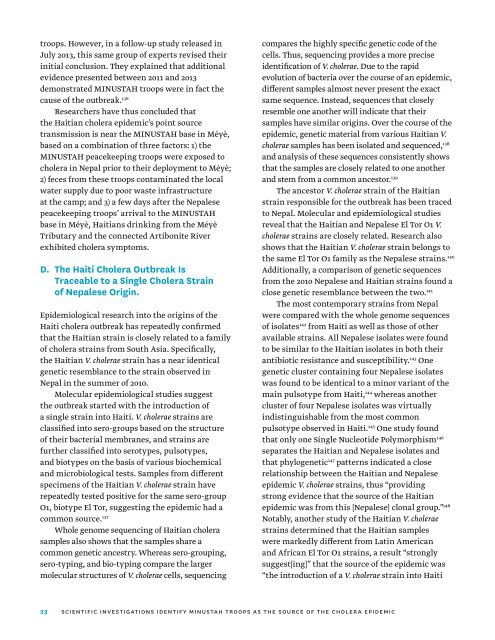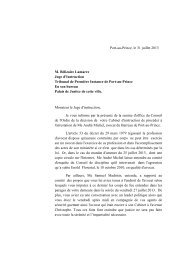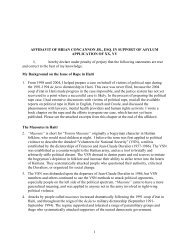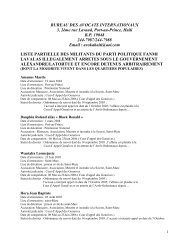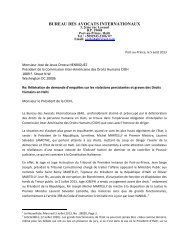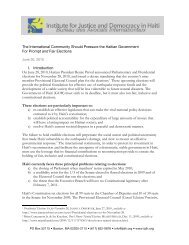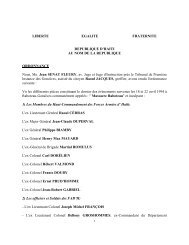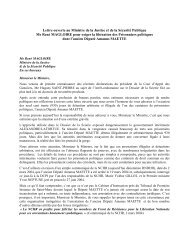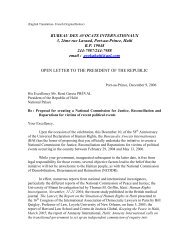Peacekeeping without Accountability - Yale Law School
Peacekeeping without Accountability - Yale Law School
Peacekeeping without Accountability - Yale Law School
- No tags were found...
Create successful ePaper yourself
Turn your PDF publications into a flip-book with our unique Google optimized e-Paper software.
troops. However, in a follow-up study released inJuly 2013, this same group of experts revised theirinitial conclusion. They explained that additionalevidence presented between 2011 and 2013demonstrated MINUSTAH troops were in fact thecause of the outbreak. 136Researchers have thus concluded thatthe Haitian cholera epidemic’s point sourcetransmission is near the MINUSTAH base in Méyè,based on a combination of three factors: 1) theMINUSTAH peacekeeping troops were exposed tocholera in Nepal prior to their deployment to Méyè;2) feces from these troops contaminated the localwater supply due to poor waste infrastructureat the camp; and 3) a few days after the Nepalesepeacekeeping troops’ arrival to the MINUSTAHbase in Méyè, Haitians drinking from the MéyèTributary and the connected Artibonite Riverexhibited cholera symptoms.D. The Haiti Cholera Outbreak IsTraceable to a Single Cholera Strainof Nepalese Origin.Epidemiological research into the origins of theHaiti cholera outbreak has repeatedly confirmedthat the Haitian strain is closely related to a familyof cholera strains from South Asia. Specifically,the Haitian V. cholerae strain has a near identicalgenetic resemblance to the strain observed inNepal in the summer of 2010.Molecular epidemiological studies suggestthe outbreak started with the introduction ofa single strain into Haiti. V. cholerae strains areclassified into sero-groups based on the structureof their bacterial membranes, and strains arefurther classified into serotypes, pulsotypes,and biotypes on the basis of various biochemicaland microbiological tests. Samples from differentspecimens of the Haitian V. cholerae strain haverepeatedly tested positive for the same sero-groupO1, biotype El Tor, suggesting the epidemic had acommon source. 137Whole genome sequencing of Haitian cholerasamples also shows that the samples share acommon genetic ancestry. Whereas sero-grouping,sero-typing, and bio-typing compare the largermolecular structures of V. cholerae cells, sequencingcompares the highly specific genetic code of thecells. Thus, sequencing provides a more preciseidentification of V. cholerae. Due to the rapidevolution of bacteria over the course of an epidemic,different samples almost never present the exactsame sequence. Instead, sequences that closelyresemble one another will indicate that theirsamples have similar origins. Over the course of theepidemic, genetic material from various Haitian V.cholerae samples has been isolated and sequenced, 138and analysis of these sequences consistently showsthat the samples are closely related to one anotherand stem from a common ancestor. 139The ancestor V. cholerae strain of the Haitianstrain responsible for the outbreak has been tracedto Nepal. Molecular and epidemiological studiesreveal that the Haitian and Nepalese El Tor O1 V.cholerae strains are closely related. Research alsoshows that the Haitian V. cholerae strain belongs tothe same El Tor O1 family as the Nepalese strains. 140Additionally, a comparison of genetic sequencesfrom the 2010 Nepalese and Haitian strains found aclose genetic resemblance between the two. 141The most contemporary strains from Nepalwere compared with the whole genome sequencesof isolates 142 from Haiti as well as those of otheravailable strains. All Nepalese isolates were foundto be similar to the Haitian isolates in both theirantibiotic resistance and susceptibility. 143 Onegenetic cluster containing four Nepalese isolateswas found to be identical to a minor variant of themain pulsotype from Haiti, 144 whereas anothercluster of four Nepalese isolates was virtuallyindistinguishable from the most commonpulsotype observed in Haiti. 145 One study foundthat only one Single Nucleotide Polymorphism 146separates the Haitian and Nepalese isolates andthat phylogenetic 147 patterns indicated a closerelationship between the Haitian and Nepaleseepidemic V. cholerae strains, thus “providingstrong evidence that the source of the Haitianepidemic was from this [Nepalese] clonal group.” 148Notably, another study of the Haitian V. choleraestrains determined that the Haitian sampleswere markedly different from Latin Americanand African El Tor O1 strains, a result “stronglysuggest[ing]” that the source of the epidemic was“the introduction of a V. cholerae strain into Haiti23scientific investigations identify minustah troops as the source of the cholera epidemic


